 shipping
shipping Have Your Wine, And Enjoy It Too!
 Monday, November 15, 2010 at 1:31PM
Monday, November 15, 2010 at 1:31PM I want everybody who enjoys Deerfield wine to be able to have it on their table anywhere in the world and the internet helps people to do that. That being said I encourage people to buy Deerfield wine online and it's a convenient way to be able to experience it if Sonoma Valley is a plane ticket away. I do have some advice though to help make drinking a bottle of Sangiovese in Germany as similar as possible to drinking it straight out of the barrel in the Cave.
Keep in mind that wine is alive. It's ever changing and like the rest of us can get stressed. Robert often remarks that wine is unique because it is not a solution - it is a suspension. In a solution, solids are dissolved in a liquid such as salt dissolved in water. In a suspension, like wine, microscopic solids actually hang in formation within the liquid. So jostling the wine around can shake up these very fragile bonds that when connected create the depth and complexity found in all Deerfield wines. You may have heard the term "bottle shock". After a wine goes through the traumatizing experience of the bottling line it can lose its cool. Maybe it doesn't like the loud noises - I'm not too sure... But what often follows is a period where the wine tastes one-dimensional: The flavor is there but the body isn't. The good news is that after a month or two the wine pulls its act together. If you can restrain yourself and wait a few months to open a bottle you will be rewarded.
A similar thing happens when a wine is shipped. Its journey impacts it. Travel tends to fray our ends a little bit and wine is no different. So if you order a bottle: Thank you, now do yourself a favor and stick in the cellar for at least a few weeks, then bring it to your friend's house and enjoy it with company for the full experience.
Wine is also very sensitive to temperature. Our cave is ideal because it stays a constant 60º. For that reason we do not ship to Alabama, Arkansas, Kentucky, Maryland, Massachusetts, Mississippi, Pennsylvania, Utah by Ground when the weather is too hot. For all other states we can deliver by way of refrigerated truck. In our experience, sending it by 3 Day Air gets the wine to you safely if you live in one of the aforementioned states. Make sure that you will be home to sign for the package as an adult signature is required. State laws have made shipping wine to certain states challenging however, we can accommodate shipping to most states so give us a call or order online!
 shipping
shipping SF MOMA: "How Wine Became Modern"
 Wednesday, November 24, 2010 at 5:56PM
Wednesday, November 24, 2010 at 5:56PM  Wine has been around for a long time. There is evidence of winemaking dating back 6500 years ago, so it’s not exactly a new facet of civilization. Yet the role that wine plays in our modern culture is definitely enjoying a rapid expansion. That’s what the San Francisco Museum of Modern Art is taking a look at in its new installation “How Wine Became Modern: Design and Wine, 1976 to Now”. It opened this weekend so I cruised down to the City to check it out,
Wine has been around for a long time. There is evidence of winemaking dating back 6500 years ago, so it’s not exactly a new facet of civilization. Yet the role that wine plays in our modern culture is definitely enjoying a rapid expansion. That’s what the San Francisco Museum of Modern Art is taking a look at in its new installation “How Wine Became Modern: Design and Wine, 1976 to Now”. It opened this weekend so I cruised down to the City to check it out,
The Exhibits:
 If you’re not familiar with the historic “Judgement of Paris”, in which two California wines trumped the first growth French counterparts in a blind tasting on their home turf, you can watch the film Bottleshock to get up to speed (plus Bill Pullman hasn’t been this good since Independence Day). If you do remember that day that reshaped the notion that quality wine is exclusively synonymous with Bordeaux, than you may enjoy the large mural depicting the judges in a style reminiscent of The Last Supper. The actual bottle of 1973 Chateau Montelena and 1973 Stag’s Leap, with the issue of Time chronicling the event might impress you even more.
If you’re not familiar with the historic “Judgement of Paris”, in which two California wines trumped the first growth French counterparts in a blind tasting on their home turf, you can watch the film Bottleshock to get up to speed (plus Bill Pullman hasn’t been this good since Independence Day). If you do remember that day that reshaped the notion that quality wine is exclusively synonymous with Bordeaux, than you may enjoy the large mural depicting the judges in a style reminiscent of The Last Supper. The actual bottle of 1973 Chateau Montelena and 1973 Stag’s Leap, with the issue of Time chronicling the event might impress you even more.
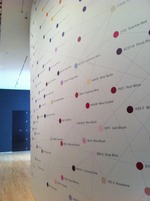 Pantone 221 – Cabernet. A wall chronicling every wine-related paint color reveals how your local paint shop probably has a better wine selection than your local supermarket.
Pantone 221 – Cabernet. A wall chronicling every wine-related paint color reveals how your local paint shop probably has a better wine selection than your local supermarket.
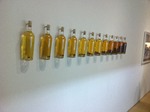 One of my personal favorites was a series of bottles of Chardonnay in which the artist added oak chips to each bottle according to the Fibonacci sequence, in which each number is the sum of the two preceding numbers, producing a perfect gradient of color.
One of my personal favorites was a series of bottles of Chardonnay in which the artist added oak chips to each bottle according to the Fibonacci sequence, in which each number is the sum of the two preceding numbers, producing a perfect gradient of color.
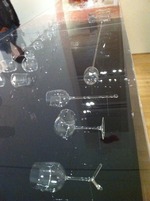 Wine was even dripping from the ceiling into a case of eclectic stemware. Some of the pieces emphasized function while others emphasized…erm…well…the stem. Still I enjoyed the novelty and the decanters definitely belonged in a museum (although they were also available in the gift store).
Wine was even dripping from the ceiling into a case of eclectic stemware. Some of the pieces emphasized function while others emphasized…erm…well…the stem. Still I enjoyed the novelty and the decanters definitely belonged in a museum (although they were also available in the gift store).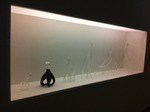
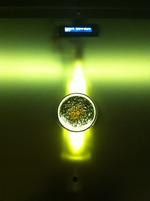 The most educational exhibit was definitely the look at the concept of terroir. Their approach was to take soil samples from all over the world and display them along with live weather reports, a quote from the grower about their view on terroir, and the raw statistics of the vineyard such as annual rainfall and average root depth.
The most educational exhibit was definitely the look at the concept of terroir. Their approach was to take soil samples from all over the world and display them along with live weather reports, a quote from the grower about their view on terroir, and the raw statistics of the vineyard such as annual rainfall and average root depth. 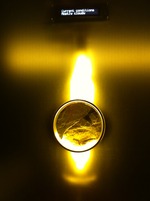 I noticed that most of the Old World growers espoused the exemplary qualities of their vineyard’s location while growers from New World countries highlighted the impact of the human element on terroir.
I noticed that most of the Old World growers espoused the exemplary qualities of their vineyard’s location while growers from New World countries highlighted the impact of the human element on terroir.
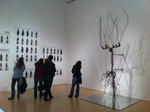 An entire wall was dedicated to label art, with overlapping categories separating themes like “Good Vs. Evil” and “Femme”. We see the label art whenever we go shopping but seeing it broken down like this really makes you think twice about the label and the message it tries to convey.
An entire wall was dedicated to label art, with overlapping categories separating themes like “Good Vs. Evil” and “Femme”. We see the label art whenever we go shopping but seeing it broken down like this really makes you think twice about the label and the message it tries to convey.
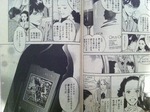 There was a display studying wine’s impact on literature. There’s a Japanese manga apparently that is all about wine and, in fact, it actually impacts Eastern Asian buying patterns. Who knew?!
There was a display studying wine’s impact on literature. There’s a Japanese manga apparently that is all about wine and, in fact, it actually impacts Eastern Asian buying patterns. Who knew?!
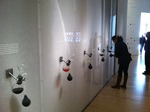 Usually smell isn’t on display at MOMA but it was in “How Wine Became Modern”. A wall highlighting the more unusual smells wine critics identify such as Cat’s Pee and Hamster Cage were present for all to sniff.
Usually smell isn’t on display at MOMA but it was in “How Wine Became Modern”. A wall highlighting the more unusual smells wine critics identify such as Cat’s Pee and Hamster Cage were present for all to sniff.
On the way out was a screen rapidly flashing videos related to the consumption of wine taken from television and film over the decades. For me, this piece best illustrated how wine has stained the fabric of our lives.
 wine events
wine events Vineyard Voodoo
 Wednesday, December 1, 2010 at 9:20AM
Wednesday, December 1, 2010 at 9:20AM One of the questions that I’m most frequently asked is “What’s the difference between biodynamic and organic farming and what the heck does biodynamic mean anyway?” It’s a fair question that is increasingly relevant to the consumer as biodynamic wines garner more attention in the media. You may know that organic farming basically requires that no synthetic chemicals are used and that the system is sustainable, meaning it is self-contained and endlessly renewable. Biodynamic agriculture is an extension of those ideals and a philosophy that has some pretty New Age sounding ideas but actually dates back to 1924 when Rudolph Steiner gave a series of lectures to German farmers who had noticed that the health of their crops had deteriorated with the use of chemical fertilizers. His central idea was that the farm is an organism and that each of its parts is interdependent, including the farmer.
Biodynamic agriculture focuses on promoting soil health which proponents claim is the key to everything from minimizing the impact of pests and weeds to maximizing quality. Additionally, the farm is believed to be best served by being self-sustaining. Soil health is achieved mainly by creating organic compost using 7 “preparations” which Steiner proposed and can be found here. Two field preparations are outlined as well, including stuffing a cow horn with manure and burying it, and spraying a solution of crushed quartz and water over the field.
Animals are integral to biodynamic farming and ideally the manure should come from animals living on the farm itself. Astrology also figures heavily into the philosophy, and the position of heavenly bodies governs the timing of planting, fertilization and the harvest. If you’re the pragmatic type who scoffs when somebody asks you what your sign is, consider that the term “harvest moon” is deeply ingrained into our culture. The practice continues to evolve and include new ideas: In Deerfield’s vineyard there are several large boulders placed strategically (if not conveniently) to “anchor” the energy of the vineyard and prevent it from escaping.
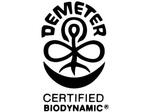 To ensure that agricultural producers meet the stringent requirements that the philosophy espouses, Demeter International has certified farmers in the practice of biodynamic agriculture in over 50 countries since 1928. Organic and bio dynamic farming have significant benefits over conventional farming, including higher quality produce, more efficient, sustainable crops, and improved soil conditions. A high-profile blind tasting hosted by Fortune had top judges picking wines produced from biodynamically grown grapes 9 times out of 10. Personally I believe that ecological systems work best in the long term when modeled after natural systems and for that reason the core principles of biodynamic agriculture seem like a common sense approach.
To ensure that agricultural producers meet the stringent requirements that the philosophy espouses, Demeter International has certified farmers in the practice of biodynamic agriculture in over 50 countries since 1928. Organic and bio dynamic farming have significant benefits over conventional farming, including higher quality produce, more efficient, sustainable crops, and improved soil conditions. A high-profile blind tasting hosted by Fortune had top judges picking wines produced from biodynamically grown grapes 9 times out of 10. Personally I believe that ecological systems work best in the long term when modeled after natural systems and for that reason the core principles of biodynamic agriculture seem like a common sense approach.
 biodynamic,
biodynamic,  organic,
organic,  viticulture
viticulture Nice Rack
 Friday, December 17, 2010 at 1:35PM
Friday, December 17, 2010 at 1:35PM Winter can be a lonely time for a cellar rat. The hustle and bustle of harvest has faded away and the wines are sleeping in the cave. Outside the air is almost freezing, making the 60 degrees of the cave seem cozy. Most of the work during the off-season can be done solo, leaving you with the barrels as your companions.
In this post I talked about the endless process of keeping the barrels topped. With 2500 barrels to keep full to the brim there’s plenty to do. The other major process that takes place year-round is called racking. Racking is another element in making clean wine. Cleaning the barrels throughout the process reduces the likelihood of bacteria or mold affecting the wine. It’s a technique that’s been used for thousands of years. It involves moving the wine from one vessel to another. There are several reasons that racking is useful to the winemaker. After fermentation and the grapes are pressed, small solid particles, including the yeast, remain present in the wine. These sediments slowly settle on the bottom of the barrel like silt does on a river bed. Instead of trying to filter these particles out, we simply draw the wine off of the top of the sediment and into another vessel. This mixture of yeast and other particles is known as the lees. You may have seen a wine label mention that it was aged sur lees. This essentially means that it was never racked.
It’s for this reason that we have closed top stainless steel tanks as well as open ones. During fermentation the reaction creates enough CO2 to protect the juice from oxygen. Afterwards the wine must not be exposed to oxygen in large volumes, so the wine is racked from the barrels into the controllable environment of the tank. Often we pump nitrogen through the wine, essentially pushing the oxygen out of the liquid and filling the remaining space in the tank. Then we rinse the barrels using a specialized hose attachment that’s really just a glorified sprinkler. Then we steam clean them which uses only 2 gallons of water compared to the 22 gallons that are used during conventional hot water cleaning. When the barrels have been cleaned and drained the wine is returned to them. This process usually gets repeated several times before the wine is bottled. With each successive racking the wine becomes more and more clear. We call it clarification. Additionally to finish the process, we have high quality filtration technology which removes microscopic solids giving the wines a jewel-like characteristic.
The challenge lies in the fact that the large tanks are outside and the barrels are all inside. The barrels are all packed into the cave like a jigsaw puzzle and removing a particular barrel often means moving an entire row to get to it. It’s the winemaker’s job to plan where to put the barrels and when to rack them but it’s the cellar rat’s job to get the barrels out! I must admit that I admire our Cellar Master Aron’s ability to maneuver the forklift in the close quarters of the cave.
Until next time! Salut!
 winemaking
winemaking Eat Locally @ Locavore!
 Friday, January 14, 2011 at 5:14PM
Friday, January 14, 2011 at 5:14PM One great thing about living in the Sonoma Valley is that you get to enjoy the country life style but you’re only an hour away from the multitude of fine dining options to be found in the City By The Bay. Deerfield has made a commitment to only sourcing fruit locally, from within a 20 mile radius of the winery. We always like to do business with like-minded companies, which is why we’re excited that our wines are on the menu at the new San Francisco eatery Locavore. The restaurant was founded on principles of nourishing people with foods and beverages that are organic and produced locally. All the ingredients used by Locavore were produced in a 100 mile radius of their Mission District location.
They’ve been open for about two months now and San Francisco residents resonate with these ideas and have flocked to the spot. Next week they’re celebrating the successful opening with their first event. Ryan Rugg and I are heading down to pour some wines and help them kick it off.
Tuesday, January 18th from 5pm to 7pm we’ll be hanging out at Locavore located at 3215 Mission St. San Francisco. More info.
Our 2006 Merlot Cuveé was selected by executive chef Jason Moniz for their locally crafted wine list because of its versatility and ability to pair with a diverse course selection. In order to offer guest more for the evening we’ll be bringing with us the newly released 2009 Sauvignon Blanc and everyone’s favorite, Red Rex.
See you there!
 wine events
wine events 
